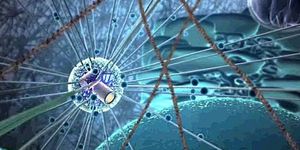Space & Astronomy
Crashing Into History
APR 27, 2015 9:31 AM PDT
Share
Ancient Viruses, Once Foes, May Now Serve as Friends
 Our genomes are riddled with the detritus of ancient viruses. They infected our hominid ancestors tens of millions of years ago, inserting their genes into the DNA of their hosts.
Our genomes are riddled with the detritus of ancient viruses. They infected our hominid ancestors tens of millions of years ago, inserting their genes into the DNA of their hosts.Today, we carry about 100,000 genetic remnants of this invasion. So-called endogenous retroviruses make up 8 percent of the human genome.
Mostly, these genetic fragments are generally nothing more than molecular fossils. Over thousands of generations, they have mutated so much that they cannot replicate in our cells. And our cells keep the viral DNA muzzled to minimize the harm it might cause.
But scientists are finding that some endogenous retroviruses do wake up, and at the strangest time.
A new study published in the journal Nature on Monday suggests that endogenous retroviruses spring to life in the earliest stages of the development of human embryos. The viruses may even assist in human development by helping guide embryonic development and by defending young cells from infections by other viruses.
"The fact that viruses may be playing a vaccine role inside the cell is pretty amazing," said Guillaume Bourque, a genomicist at McGill University who was not involved in the study.
When an ordinary retrovirus, like H.I.V., infects a cell, it inserts its genes into the cell's DNA. The cell then makes new retroviruses by making a copy of the virus's genes as RNA molecules. The cell uses some of those RNA molecules to make proteins for the virus. Those proteins form a shell around the other RNA molecules, which become the new virus's genes.
In recent years, scientists have discovered that embryonic cells produce RNA molecules from certain endogenous retroviruses lurking in the genome. But scientists have struggled to understand why.
Do retroviruses come out of hiding to take advantage of their young hosts when their defenses are weak? Or are these just biochemical accidents - embryonic cells mistakenly turning viral genes into RNA, then destroying their molecular mistakes?
Joanna Wysocka, a developmental biologist at Stanford University, and her colleagues recently discovered evidence that embryonic cells are not turning to their viral genes by accident. It's an elaborate process that happens at a specific time in the development of an embryo. "It's part of the program," she said.
Dr. Wysocka and her colleagues did not actually set out to study viruses when they started their research. Instead, they were investigating how a single fertilized egg turns into the hundreds of different types of cells in the human body.
In the early stages of development, an embryo is largely made up of cells that can potentially become any sort of tissue. Over the course of many divisions, the cells continue to hold on to this potential. A crucial reason is a protein called Oct4.
It's not entirely clear how Oct4 keeps embryonic cells in their flexible state, but scientists know it works by latching on to DNA in order to turn genes on and off. Dr. Wysocka and her colleagues found that one of Oct4's favorite targets was a kind of endogenous retrovirus called HERV-K.
Oct4 was not merely grabbing on to HERV-K, the scientists eventually learned, but also triggering cells to make RNA from the viral genes. And the story did not stop there.
The embryonic cells then used some of the viral RNA to make proteins. The proteins were assembled into particles that bore a striking resemblance to retroviruses; some even budded off the surface of the cells, as viruses do.
It could be that these particles are weakened HERV-K viruses, faint echoes of an ancient invader. "We showed them to virologists, and they said, ‘Yes, this looks like retroviruses to me,' " Dr. Wysocka said.
Still, she added, "We don't have any evidence at this point that they're infectious."
Embryonic cells make HERV-K viruses for only a few days. They stop around the time an embryo implants on the wall of the uterus. During this window, the viruses alter embryonic cells in some potentially important ways.
A cell can sense new viral genes floating around its interior. It can respond to this threat by creating immune defenses against more invasions. Dr. Wysocka and her colleagues found that when HERV-K reawakens, the embryonic cell builds proteins on its surface that help ward off other viruses that may be trying to get inside.
In the lab, the scientists tried infecting these cells with influenza viruses. Those producing HERV-K were better able to resist the flu virus than cells that were not. It's possible, in other words, that this endogenous retrovirus protects embryos from other viruses.
The retroviral genes may even be guiding the development of embryos. Proteins made from HERV-K's genetic instructions ferry some of the cell's own RNA to its protein-building factories. Dr. Wysocka speculated that the viruses may be altering the balance of available proteins at a pivotal time during development - right when a clump of cells is going to turn into a complex body.
Stephen Goff, a microbiologist at Columbia University, said that the new study demonstrates that through evolution, the human genome has domesticated primeval enemies. Our viral antagonists are now "handy tools in our genomic toolbox," he said.
Jonathan Stoye, a virologist at the Francis Crick Institute in London, considered the study "thought worthy," but cautioned that Dr. Wysocka and her colleagues had not proved that the retroviral genes are providing clear benefits to human embryos. Endogenous retroviruses might behave "merely as very successful parasites," he said.
Dr. Wysocka acknowledged that the evidence she and her colleagues had gathered was only suggestive at this point. But whatever the viruses are up to, Dr. Wysocka argued, they are doing something important during the development of human embryos.
"This is a completely new thing that we need to be considering," she said.
Article by Carl Zimmer
[Source: nyt.com]
You May Also Like
Loading Comments...








